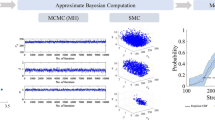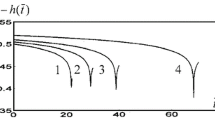Abstract
An upper bound is obtained on the probability distribution for the strength of composite materials. The analysis is based on the chain-of-bundles probability model, and local load sharing is assumed for the nonfailed fiber elements in each bundle. The bound is based on the occurence of two or more adjacent broken fibers in a bundle. This event is necessary but not sufficient for the failure of the material. Two distributions are assumed for fiber strength: the usual Weibull distribution and a more realistic double version which has much the effect of putting a ceiling on fiber strength. For large composite materials, the upper bound becomes a Weibull distribution but with a shape parameter which is twice that for the individual fibers. The bound is always conservative, but it is extremely tight when the variability in fiber strength is low. In typical cases, the use of the double Weibull distribution for fiber strength is shown not to affect the behavior of the bound significantly. In view of the additional experimental and computational labor involved, its use in practice may not be justified in such cases. However, its use does shed light on fracture processes in composite materials.
Résumé
On obtient une borne supérieure dans la distribution des probabilités relatives à la résistance des matériaux composites. L'analyse est basée sur un modèle de probabilités de chaine de bottes et on suppose une redistribution locale des charges dans le cas d'éléments fibreux non rompus dans chaque botte. Le définition de la frontière se base sur l'apparition de deux ou de plusieurs fibres rompues adjacentes dans une botte. Cette circonstance est nécessaire mais pas suffisante pour entraîner la rupture du matériau. Deux distributions sont supposées intervenir dans la résistance de la fibre: la distribution habituelle de Weibull d'une part et une version plus réaliste dont l'effet est essentiellement de déterminer un plafond à la résistance de la fibre. Dans le cas de matériaux composites de grande dimension, la limite supérieure devient une distribution de Weibull mais avec un paramètre de forme qui équivaut à deux fois celui des fibres individuelles. La limite est toujours conservative mais peut être extrêmement étroite lorsque la variation de la résistance de la fibre est faible. Dans des cas typiques, l'utilisation de la double distribution de Weibull pour une résistance de fibre se révèle ne pas affecter le comportement de la frontière d'une manière significative. Vu les travaux expérimentaux et de calculs additionnels qui sont rendus nécessaires, son utilisation en pratique ne se justifie pas dans de tels cas. Cependant, cette utilisation permet de jeter la lumière sur des processus de rupture des matériaux composites.
Similar content being viewed by others
References
D.G. Harlow and S.L. Phoenix, International Journal of Fracture, 15 (1979) 321–336.
D.G. Harlow and S.L. Phoenix, Journal of Composite Materials, 12 (1978) 195–214.
D.G. Harlow and S.L. Phoenix, Journal of Composite Materials, 12 (1978) 314–334.
J.A. Kies, NRL Report 6034, United States Naval Research Laboratories, Washington, D.C. (1964).
A.G. Metcalfe and G.K. Schmitz, Proceedings of the ASTM, 64 (1964) 1075–1093.
S.L. Phoenix, Composite Reliability, ASTM STP 580, American Society for Testing and Materials (1975) 77–89.
S.L. Phoenix and R.G. Sexsmith, Journal of Composite Materials 6 (1972) 322–337.
B.W. Rosen, AIAA Journal, 2 (1964) 1985–1991.
C. Zweben, AIAA Journal, 6 (1968) 2325–2331.
C. Zweben and B.W. Rosen, Journal of Mechanics and Physics of Solids 18 (1970) 189–206.
P.M. Scop and A.S. Argon, Journal of Composite Materials, 3 (1969) 30–47.
D.G. Harlow and S.L. Phoenix, “Probability Distributions for the Strength of Fibrous Materials under Local Load Sharing I: Two-Level Failure. (submitted)
C. Zweben, Engineering Fracture Mechanics, 6 (1974) 1–10.
Author information
Authors and Affiliations
Rights and permissions
About this article
Cite this article
Harlow, D.G., Phoenix, S.L. Probability distributions for the strength of composite materials I: two-level bounds. Int J Fract 17, 347–372 (1981). https://doi.org/10.1007/BF00036188
Received:
Revised:
Issue Date:
DOI: https://doi.org/10.1007/BF00036188




